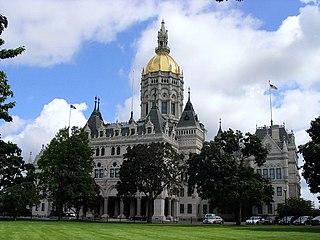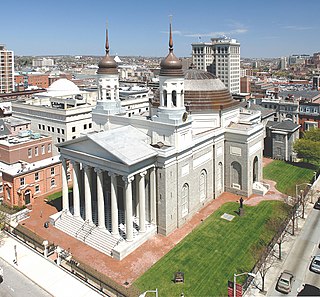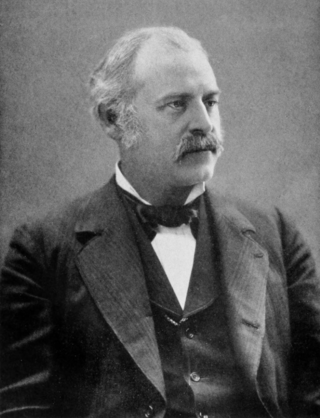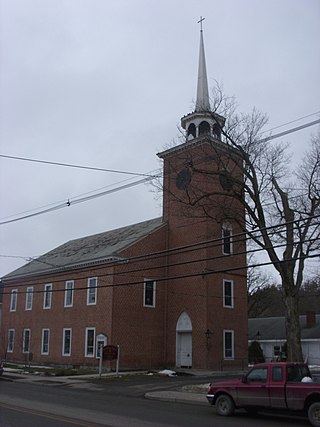Robert Cary Long Jr. (1810–1849) was the son of a late 18th Century - early 19th Century famous architect Robert Cary Long Sr. of Baltimore, Maryland and was himself a well-known 19th Century architect. Like his father, Cary was based in Baltimore.

The Cold Spring Presbyterian Church is a Presbyterian church in Cold Spring, New Jersey, founded in 1714.

The Old Town Cemetery is located in the city of Newburgh, New York, behind Calvary Presbyterian Church on South Street. It was established in 1713 by Palatine German refugees from the Rhineland-Palatinate who were transported from England in 1710 and settled on the site of the present city of Newburgh. The cemetery is within a section of the city known as the Glebe, a 500-acre (2 km2) grant made by Queen Anne to provide for a schoolmaster and clergyman for these German families. A church built by the Palatines was located on the western edge of the site, on what is now Liberty Street. As the Old Town Cemetery and Palatine Church Site, it was listed as a historic district on the National Register of Historic Places in 2000. It is also a contributing element in the larger Montgomery-Grand-Liberty Streets Historic District.

The Old First Presbyterian Church, also known as First Presbyterian Church and Cemetery, is a church in Newark, Essex County, New Jersey, United States. The church was listed on the National Register of Historic Places in 1972. The grounds, located in the Four Corners Historic District, includes an old burial ground.

St. Mary's Assumption Church is a National Historic Landmark church at Constance and Josephine Streets in New Orleans, Louisiana, U.S. The church was completed in 1860, built for the swelling German Catholic immigrant population in the Lower Garden District section of the city. Both churches are extremely beautiful and ornate.

Richard Michell Upjohn, FAIA, was an American architect, co-founder and president of the American Institute of Architects.

The Cathedral Hill Historic District is an area in Baltimore, Maryland. It lies in the northern part of Downtown just south of Mount Vernon. Roughly bounded by Saratoga Street, Park Avenue, Hamilton Street, and St. Paul Street, these 10 or so blocks contain some of the most significant buildings in Baltimore. The area takes its name from the Basilica of the Assumption which sits in the heart of the district. Despite the number of large religious structures in the area, the district's buildings are primarily commercial in character, with a broad collection of significant commercial structures ranging in date from 1790 to 1940.

Andrew Jackson Warner, also known as A. J. Warner, was a prominent architect in Rochester, New York.
First Presbyterian Church of Dailey Ridge, also known as Reformed Presbyterian Church of the Town of Potsdam, is a historic Presbyterian church located at Potsdam in St. Lawrence County, New York. It was built in 1853 and is a modest, two story wood-frame building with a painted clapboard exterior and a simple, gable front, rectangular plan typical of mid 19th century rural churches. Located adjacent is the church cemetery.
Brick Chapel Church and Cemetery is a historic Presbyterian church and cemetery located at Canton in St. Lawrence County, New York. The church was built in 1858 for the local Methodist congregation, who merged with the Presbyterians in the 1910s. It is a 40 feet by 56 feet brick structure resting on a raised ashlar limestone foundation. It features a large, square engaged bell tower on the front facade. Also on the property is a cemetery with burials dating to 1809.

German Presbyterian Church and Hortonville Cemetery, also known as Hortonville Presbyterian Church, is a historic Presbyterian church and cemetery located at CR 121 and CR 131 in Hortonville, Sullivan County, New York. The church was built about 1860 and is a one-story, rectangular wood-frame building, 27 feet long and 41 feet wide. It features a steep gable roof with two stage tower and small spire. The cemetery is located about a quarter mile from the church and contains approximately 100 stones. The cemetery contains the stone foundation of the original meeting house.

West Delhi Presbyterian Church, Manse, and Cemetery is a historic Presbyterian church complex and cemetery at 18 and 45 Sutherland Road in West Delhi, Delaware County, New York. The church is a one-story, rectangular wood-frame building constructed in 1892. It is surmounted by a steep gable roof with overhanging eaves. The manse was built about 1840 and is a large two story wood-frame building with a cross gable plan. The West Delhi Cemetery contains the graves of most settlement era families and features stones typical of their period and style.

First Presbyterian Church and Cemetery is located at 600 Rahway Avenue in Woodbridge Township, Middlesex County, New Jersey, United States, one of the first townships established in the state at the end of the 17th century.

Harmony Hill Methodist Church is a Methodist Episcopal house of worship affiliated with the United Methodist Church and located about one mile north of the village of Stillwater in Stillwater Township, in the Sussex County, New Jersey, United States.

Kingston Presbyterian Church Cemetery is a historic cemetery located at Conway in Horry County, South Carolina. It contains fine examples of Victorian-era funerary art, especially those in the Beaty family plot. Portions of the cemetery site were first the old Kingston "burying ground", established about 1737, and burials continued until 1909. It is co-located with the Kingston Presbyterian Church, listed on the National Register of Historic Places in 2009.
Isaac Pursell was a Philadelphia, Pennsylvania-based architect.

Union Presbyterian Church is a historic building located northwest of Stacyville in rural Mitchell County, Iowa, United States. Early settlers to the area of German descent established the Presbyterian congregation in the late 1850s. They initially worshiped in the homes of various church members before joining St. Peter's Lutheran Church in nearby Toeterville. Doctrinal differences resulted and the Rev. Jacob Kolb reformed the Presbyterian congregation in 1873 or 1874. Services were held in a schoolhouse until this church building was erected in 1888. It is a small frame structure with Gothic-style elements, with extensive use of pressed tin on the interior. A cemetery is located on the church grounds. Services were held in German until 1918. There was a steady decline in membership until the congregation was disbanded in 1975. The building was listed on the National Register of Historic Places in 1977.

Spencertown is a hamlet in the town of Austerlitz, Columbia County, New York, United States. Its ZIP code is 12165.

Mount Airy is an unincorporated community located within West Amwell Township in Hunterdon County, in the U.S. state of New Jersey.

St. Paul's Lutheran Church Historic District, also known as Schoharie United Presbyterian Church, is a historic Lutheran church complex and national historic district located at Schoharie, Schoharie County, New York. The complex consists of the former St. Paul's Lutheran Church, an 1801 manse, St. Paul's Lutheran Cemetery, and the old Lutheran Parsonage. The church was built in 1796, and is a two-story rectangular brick building. The front facade features a square, multistage entrance tower capped by an octagonal belfry and spire. The new manse was built in 1801, and is a five bay, two-story, double pile, heavy timber frame Federal style dwelling with a two-story rear ell. The church cemetery has several thousand graves, with the earliest marked grave dated to 1778. The Old Lutheran Parsonage was built in 1743, and is separately listed. In 1920, the local Lutheran and Methodist congregations joined, and in 1960, the congregation voted to affiliate with the Presbyterian denomination.


















